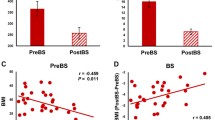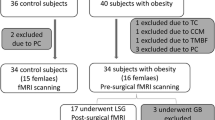Abstract
Background
Lateral and medial hypothalamus (LH and MH) play important roles in energy balance. Changed hypothalamic function has been found in subjects with obesity. However, the effect of bariatric surgery on the function of the two sub-regions has been poorly investigated.
Methods
Thirty-eight subjects with obesity and 34 age- and sex-matched normal-weight controls were included. Seventeen of the 38 subjects underwent laparoscopic sleeve gastrectomy. Functional magnetic resonance imaging data and metabolic parameters were collected to investigate functional connectivity networks of the two hypothalamic sub-regions as well as the influence of sleeve gastrectomy on the two networks in subjects with obesity.
Results
Compared to normal-weight controls, pre-surgical subjects had increased functional connectivity (FC) in the reward region (putamen) within the LH network, and increased FC in somatosensory cortical area (insula), as well as decreased FC in the cognitive control regions (prefrontal regions) within the MH network. After the surgery, post-surgical FC of the putamen within the LH network changed towards the patterns found in the control group. Furthermore, the changes in fasting glucose before and after the surgery were associated with the changes in FC of the putamen within the LH network.
Conclusions
The FC within the LH and MH networks were changed in subjects with obesity. Part of these altered FC was rescued after the surgery.




Similar content being viewed by others
References
Withrow D, Alter DA. The economic burden of obesity worldwide: a systematic review of the direct costs of obesity. Obes Rev. 2011;12(2):131–41.
Rexford S, Ahima MAL. The health risk of obesity-better metrics imperative. Science. 2013;341:856–7.
Schlögl H, Horstmann A, Villringer A, et al. Functional neuroimaging in obesity and the potential for development of novel treatments. Lancet Diabetes Endocrinol. 2016;4(8):695–705.
Volkow ND, Wise RA, Baler R. The dopamine motive system: implications for drug and food addiction. Nat Rev Neurosci. 2017 Nov 16;18(12):741–52.
Kullmann S, Heni M, Linder K, et al. Resting-state functional connectivity of the human hypothalamus. Hum Brain Mapp. 2014;35(12):6088–96.
Cavadas C, Aveleira CA, Souza GF, et al. The pathophysiology of defective proteostasis in the hypothalamus—from obesity to ageing. Nat Rev Endocrinol. 2016;12(12):723–33.
Hetherington AW, Ranson SW. Hypothalamic lesions and adiposity in the rat. Anat Rec. 1940;78(2):149–72.
Bonnavion P, Mickelsen LE, Fujita A, et al. Hubs and spokes of the lateral hypothalamus: cell types, circuits and behaviour. J Physiol. 2016;594(22):6443–62.
Kempadoo KA, Tourino C, Cho SL, et al. Hypothalamic neurotensin projections promote reward by enhancing glutamate transmission in the VTA. J Neurosci. 2013;33(18):7618–26.
Baimel C, Bartlett SE, Chiou LC, et al. Orexin/hypocretin role in reward: implications for opioid and other addictions. Br J Pharmacol. 2015;172(2):334–48.
Cansell C, Denis RG, Joly-Amado A, et al. Arcuate AgRP neurons and the regulation of energy balance. Front Endocrinol (Lausanne). 2012;3:169.
Konner AC, Klockener T, Bruning JC. Control of energy homeostasis by insulin and leptin: targeting the arcuate nucleus and beyond. Physiol Behav. 2009;97(5):632–8.
Pandit R, Omrani A, Luijendijk MC, et al. Melanocortin 3 receptor signaling in midbrain dopamine neurons increases the motivation for food reward. Neuropsychopharmacology. 2016;41(9):2241–51.
Morton GJ, Cummings DE, Baskin DG, et al. Central nervous system control of food intake and body weight. Nature. 2006;443(7109):289–95.
Jastreboff AM, Sinha R, Arora J, et al. Altered brain response to drinking glucose and fructose in obese adolescents. Diabetes. 2016;65(7):1929–39.
Heni M, Kullmann S, Ketterer C, et al. Differential effect of glucose ingestion on the neural processing of food stimuli in lean and overweight adults. Hum Brain Mapp. 2014;35(3):918–28.
Frank S, Linder K, Kullmann S, et al. Fat intake modulates cerebral blood flow in homeostatic and gustatory brain areas in humans. Am J Clin Nutr. 2012;95(6):1342–9.
Roth CL, Eslamy H, Werny D, et al. Semiquantitative analysis of hypothalamic damage on MRI predicts risk for hypothalamic obesity. Obesity (Silver Spring). 2015;23(6):1226–33.
Thaler JP, Yi C-X, Schur EA, et al. Obesity is associated with hypothalamic injury in rodents and humans. J Clin Invest. 2012;122(1):153–62.
Carus-Cadavieco M, Gorbati M, Ye L, et al. Gamma oscillations organize top-down signalling to hypothalamus and enable food seeking. Nature. 2017;542(7640):232–6.
Lips MA, Wijngaarden MA, van der Grond J, et al. Resting-state functional connectivity of brain regions involved in cognitive control, motivation, and reward is enhanced in obese females. Am J Clin Nutr. 2014;100(2):524–31.
Sande-Lee S, Pereira FR, Cintra DE, et al. Partial reversibility of hypothalamic dysfunction and changes in brain activity after body mass reduction in obese subjects. Diabetes. 2011;60(6):1699–704.
Wijngaarden MA, Veer IM, Rombouts SA, et al. Obesity is marked by distinct functional connectivity in brain networks involved in food reward and salience. Behav Brain Res. 2015;287:127–34.
Hinkle W, Cordell M, Leibel R, et al. Effects of reduced weight maintenance and leptin repletion on functional connectivity of the hypothalamus in obese humans. PLoS One. 2012;8(3):e59114.
Halpern CH, Wolf JA, Bale TL, et al. Deep brain stimulation in the treatment of obesity. J Neurosurg. 2008;109(4):625–34.
Whiting DM, Tomycz ND, Bailes J, et al. Lateral hypothalamic area deep brain stimulation for refractory obesity: a pilot study with preliminary data on safety, body weight, and energy metabolism. J Neurosurg. 2013;119(1):56–63.
Li P, Shan H, Liang S, et al. Sleeve gastrectomy recovering disordered brain function in subjects with obesity: a longitudinal fMRI study. Obes Surg. 2018;28:2421–8.
Wiemerslage L, Zhou W, Olivo G, et al. A resting-state fMRI study of obese females between pre- and postprandial states before and after bariatric surgery. Eur J Neurosci. 2017;45(3):333–41.
Karlsson HK, Tuulari JJ, Tuominen L, et al. Weight loss after bariatric surgery normalizes brain opioid receptors in morbid obesity. Mol Psychiatry. 2016;21(8):1057–62.
Rullmann M, Preusser S, Poppitz S, et al. Gastric-bypass surgery induced widespread neural plasticity of the obese human brain. NeuroImage. 2018;172:853–63.
Chao-Gan Y, Yu-Feng Z. DPARSF: A MATLAB toolbox for “pipeline” data analysis of resting-state fMRI. Front Syst Neurosci. 2010;4:13.
Baroncini M, Jissendi P, Balland E, et al. MRI atlas of the human hypothalamus. NeuroImage. 2012;59(1):168–80.
Song XW, Dong ZY, Long XY, et al. REST: a toolkit for resting-state functional magnetic resonance imaging data processing. PLoS One. 2011;6(9):e25031.
Chow S-C, Wang H, Shao J. Sample size calculations in clinical research. Second ed. London: CRC Press; 2007.
Marques-Iturria I, Scholtens LH, Garolera M, et al. Affected connectivity organization of the reward system structure in obesity. NeuroImage. 2015;111:100–6.
Draganski B, Kherif F, Kloppel S, et al. Evidence for segregated and integrative connectivity patterns in the human basal ganglia. J Neurosci. 2008;28(28):7143–52.
Drew Sayer R, Tamer Jr GG, Chen N, et al. Reproducibility assessment of brain responses to visual food stimuli in adults with overweight and obesity. Obesity (Silver Spring). 2016;24(10):2057–63.
Jones KT, Woods C, Zhen J, et al. Effects of diet and insulin on dopamine transporter activity and expression in rat caudate-putamen, nucleus accumbens, and midbrain. J Neurochem. 2017;140(5):728–40.
Saper CB, Chou TC, Elmquist JK. The need to feed: homeostatic and hedonic control of eating. Neuron. 2002;36:1992–211.
Sano H, Yokoi M. Striatal medium spiny neurons terminate in a distinct region in the lateral hypothalamic area and do not directly innervate orexin/hypocretin- or melanin-concentrating hormone-containing neurons. J Neurosci. 2007;27(26):6948–55.
Stuber GD, Wise RA. Lateral hypothalamic circuits for feeding and reward. Nat Neurosci. 2016;19(2):198–205.
Domingos AI, Sordillo A, Dietrich MO, et al. Hypothalamic melanin concentrating hormone neurons communicate the nutrient value of sugar. Elife. 2013;2:e01462.
De Araujo IE, Rolls ET. Representation in the human brain of food texture and oral fat. J Neurosci. 2004;24(12):3086–93.
Simmons WK, Avery JA, Barcalow JC, et al. Keeping the body in mind: insula functional organization and functional connectivity integrate interoceptive, exteroceptive, and emotional awareness. Hum Brain Mapp. 2013;34(11):2944–58.
Mcguire JT, Botvinick MM. Prefrontal cortex, cognitive control, and the registration of decision costs. Proc Natl Acad Sci U S A. 2010;107(17):7922–6.
Wright H, Li X, Fallon NB, et al. Differential effects of hunger and satiety on insular cortex and hypothalamic functional connectivity. Eur J Neurosci. 2016;43(9):1181–9.
Geha P, Cecchi G, Todd Constable R, et al. Reorganization of brain connectivity in obesity. Hum Brain Mapp. 2017;38(3):1403–20.
Moreno-Lopez L, Contreras-Rodriguez O, Soriano-Mas C, et al. Disrupted functional connectivity in adolescent obesity. Neuroimage Clin. 2016;12:262–8.
Tuulari JJ, Karlsson HK, Antikainen O, et al. Bariatric surgery induces white and grey matter density recovery in the morbidly obese: a voxel-based morphometric study. Hum Brain Mapp. 2016;37(11):3745–56.
Frank S, Wilms B, Veit R, et al. Altered brain activity in severely obese women may recover after Roux-en Y gastric bypass surgery. Int J Obes. 2014;38(3):341–8.
Spitznagel MB, Hawkins M, Alosco M, et al. Neurocognitive effects of obesity and bariatric surgery. Eur Eat Disord Rev. 2015;23(6):488–95.
Guillemot-Legris O, Muccioli GG. Obesity-induced neuroinflammation: beyond the hypothalamus. Trends Neurosci. 2017;40(4):237–53.
Chiappetta S, Schaack HM, Wolnerhannsen B, et al. The impact of obesity and metabolic surgery on chronic inflammation. Obes Surg. 2018;28(10):3028–40.
Ochner CN, Gibson C, Shanik M, et al. Changes in neurohormonal gut peptides following bariatric surgery. Int J Obes. 2011;35(2):153–66.
Anderson B, Switzer NJ, Almamar A, et al. The impact of laparoscopic sleeve gastrectomy on plasma ghrelin levels: a systematic review. Obes Surg. 2013 Sep;23(9):1476–80.
Churm R, Davies JS, Stephens JW, et al. Ghrelin function in human obesity and type 2 diabetes: a concise review. Obes Rev. 2017;18(2):140–8.
Malik S, McGlone F, Bedrossian D, et al. Ghrelin modulates brain activity in areas that control appetitive behavior. Cell Metab. 2008;7(5):400–9.
Bruce AS, Bruce JM, Ness AR, et al. A comparison of functional brain changes associated with surgical versus behavioral weight loss. Obesity (Silver Spring). 2014;22(2):337–43.
Ness A, Bruce J, Bruce A, et al. Pre-surgical cortical activation to food pictures is associated with weight loss following bariatric surgery. Surg Obes Relat Dis. 2014;10(6):1188–95.
Acknowledgments
We would like to gratefully thank the patients and healthy volunteers taking part in this study.
Funding
This work was supported by the National Natural Science Foundation of China [grant numbers 81471741, 81471728, 81671770].
Author information
Authors and Affiliations
Corresponding authors
Ethics declarations
Conflict of Interest
The authors declare that they have no conflict of interest.
Ethical Statement and Consent Statement
All procedures performed in studies involving human participants were in accordance with the ethical standards of the institutional and national research committee and with the 1964 Helsinki declaration and its later amendments or comparable ethical standards. Informed consent was obtained from all individual participants included in the study.
Additional information
Publisher’s Note
Springer Nature remains neutral with regard to jurisdictional claims in published maps and institutional affiliations.
Rights and permissions
About this article
Cite this article
Li, P., Shan, H., Nie, B. et al. Sleeve Gastrectomy Rescuing the Altered Functional Connectivity of Lateral but Not Medial Hypothalamus in Subjects with Obesity. OBES SURG 29, 2191–2199 (2019). https://doi.org/10.1007/s11695-019-03822-7
Published:
Issue Date:
DOI: https://doi.org/10.1007/s11695-019-03822-7




